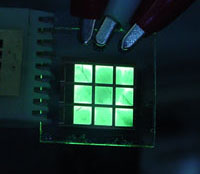ATLANTA, April 27, 2006 -- The Georgia Institute of Technology’s Center for Organic Photonics and Electronics (COPE) and Belgian chemical giant Solvay yesterday announced a $3 million, three-year deal for OLED research.
Solvay, an international chemical and pharmaceutical group headquartered in Brussels, has its Advanced Polymers business based in Alpharetta and a pharmaceutical division in Marietta. Solvay’s commitment to Georgia Tech will help fund research in OLEDs (organic light-emitting diodes), thin-films of organic molecules that give off light when electricity is applied. OLEDs could be used in everything from television and computer monitors to household lighting to handheld computing devices, such as iPods and personal digital assistants, the institute said. 
Belgian chemical giant Solvay has entered into a $3 million partnership with the Georgia Institute of Technology for research on organic light-emitting diodes (OLEDs) like these.
COPE has already developed a unique material platform for OLEDs that may be deposited over large areas by ink-jet printing and patterned using standard photolithography. Georgia Tech said its researchers have found that exposing the material to ultraviolet light leads to hardened materials that are insoluble and maintain stability under high temperatures. This allows researchers to build a multilayered solid-state device from liquid materials.
COPE, through the research group of Jean-Luc Bredas, conducts research activities with the University of Mons-Hainaut in Belgium. Georgia Tech has two international campuses, Georgia Tech Lorraine in Metz, France, and Georgia Tech Singapore.
For more information, visit: www.gatech.edu